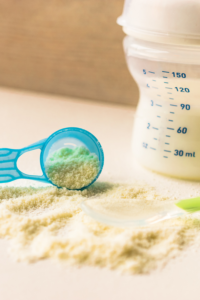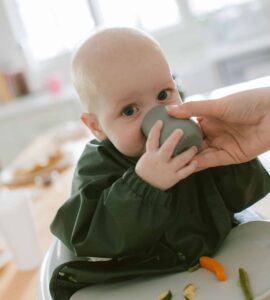Milk Weaning: The Three Major Nutrition Transitions for Toddlers
You’ve made it! Your baby is now one years old and that means they are officially a toddler and ready to make the big milk switch. There are three main transitions that happen at this age – so make sure you are prepared for each one!

Milk Weaning: The Three Major Nutrition Transitions for Toddlers
Written by: Jessica Diamond, MPH, RDN
You’ve made it! Your baby is now one years old and that means they are officially a toddler and ready to make the big milk switch. There are three main transitions that happen at this age – so make sure you are prepared for each one!
- Bye bottles! It’s time for your toddler to drink milk from an open-lid or straw cup.
- Hello milk! Pick a milk or milk alternative to replace formula or breast milk.
- Time for milk with meals! Your toddler will now consume 3 meals, each with milk, plus 1-2 snacks throughout the day (with maybe some milk before bed).
Bye bottles!
It’s time for your toddler to drink milk from an open-lid or straw cup. It can be so hard for us as parents to watch our babies grow up, but when they turn one they no longer need a bottle anymore. While it may seem like a major milestone for them (and us), it’s so much easier to drop the bottle when they are around 12 months than it is as they get older. Bottle drinking in toddlerhood can inhibit your child’s oral-motor development, lead to speech impairment and even dental issues… so at one, it really is time for us to say goodbye to it.
The only prerequisite that is needed prior to dropping the bottle is that your child needs to be 12 months old and able to drink from an open lid or straw cup. Babies at the age of around 6 months have the ability to drink from an open lid and straw cup, so if you haven’t given or tried one of those cups yet, it’s time. If they are new to cup drinking, give them a couple weeks to build up their skills before dropping the bottle. If your child is 12 months and can drink from a cup, they are ready to say goodbye to their bottles. Bottle weaning is so much harder for us than it is for your toddler – because the bottle is something we are used to and the switch represents them growing out of the baby stage we tend to have a bigger emotional attachment to the bottle than your toddler does. We’ve consulted with the experts and it’s best to do this transition cold turkey, because it can be really confusing to a child if you give them a bottle sometimes and not others. We love the using the bottle fairy technique to say bye bottles. So, mentally prepare yourself, tell your child that they are a toddler now and milk will come out of a cup instead of a bottle, and then take the leap.
Milk will now be served in a straw cup or open lid cup, whichever you prefer. Here are some tips and tricks that help. If you can, in the beginning serve water and milk out of the same looking open lid or straw cup at meals. This will help your toddler with exposure to milk because they will likely take a couple sips of milk and then go to the water, but those little tiny sips act as an exposure and usually lead to more milk drinking down the road. Once they pick up milk drinking consistently or its been awhile and no matter how much you try you don’t have a milk drinker, then offer just one cup at a meal or when they finish their milk bring over the water. Words of caution – avoid any type of sippy cup or transitional nipples. Toddlers don’t need them and they actually inhibit oral motor development so it’s actually easier than we are led to believe, there’s only two types of cups your toddler or child will need and that’s an open lid and straw cup. Now just because we don’t recommend sippy cups, doesn’t mean there aren’t spill proof options on the market. There are a lot of them and we have our favorites in our shop here.
Hello milk!
Pick a milk or milk alternative to replace formula or breast milk (if you’re ready to wean from the breast). If you’re breastfeeding and want to continue breastfeeding you do not have to stop that at 1 year, you can continue for as long as it’s right for you. Many cultures breastfeed through age 2 so if it’s working and you want to continue, go for it. If you’re ready to transition off breastmilk or if your baby is receiving formula, 12 months/1 year is the time to transition to milk (dairy based or dairy-free milk alternative).
How do you do this? There’s no one right way, but overtime I have found it’s been the most helpful to wean them to milk from breastmilk or formula over a week. That’s because the taste of milk is so different from formula and breastmilk so if you approach it with a mixture, your child is likely going to adapt quicker and it can help decrease our anxiety as parents and caregivers. Every child is different so you can speed up this transition or slow it down depending on your child, but here’s I’ve found that a 7 day transition works best for most kids when transitioning from breastmilk/formula to milk/milk alternative at 12 months:
- Day 1: 3 oz of breastmilk or formula + 1 oz of milk
- Day 2: 3 oz of breastmilk or formula + 1 oz of milk
- Day 3: 2 oz of breastmilk or formula + 2 oz of milk
- Day 4: 2 oz of breastmilk or formula + 2 oz of milk
- Day 5: 1 oz of breastmilk or formula + 3 oz of milk
- Day 6: 1 oz of breastmilk or formula + 3 oz of milk
- Day 7: 4 oz of milk
Now just because you transition like this doesn’t mean your child is going to suck down milk. A lot of times, it takes them a lot of consistency and some time to get used to it so just keep up that consistency. It’s ideal to make this transition as close to 1 year as possible so pick a day after their first birthday when you are ready and go for it!
Be sure to check out our freebie download: A Guide to Milk where we break down everything you need to know about choosing milk, milk alternatives, what to do if your child doesn’t drink milk, and nutrients to look out for in toddlerhood.
Time for milk with meals!
Your toddler will now consume 3 meals, each with milk, plus 1-2 snacks throughout the day (with maybe some milk before bed). Your toddler’s stomach is much bigger now and doesn’t need milk in between meals so they need a meal every 1.5-2 hours they are awake which means they will now have 3 meals + 1-2 snacks per day. Milk will be served with meals and then they will have a snack of food and water in between meals. The only exception to this is you can continue milk out of a cup before bed for a little while longer. We want to drop that when you start potty learning which differs widely for toddlers so you can continue milk before bed and slowly start weaning down as your toddler approaches 18 months or earlier depending on your child’s needs.
Transitioning your baby to a toddler schedule can be daunting, but it is important for their growth and development. By following these tips, you can help make the process smoother for both you and your little one.
Sample Schedule: 12-18+ Months with Two Naps
- 7:00 am – Wake up
- 7:30 am – Breakfast + milk
- 9:30 am – Nap
- 10:30 am – Snack (optional, many kids only have time for 1 snack/day)
- 12:00 pm – Lunch + milk
- 1:30 pm – Nap
- 4:00 pm – Snack (optional, many kids only have time for 1 snack/day)
- 5:30 pm – Dinner + milk
- 6:30 pm – Bath + bedtime routine
- 7:00 pm – Milk + bedtime (milk before bed is optional)
Sample Schedule: 18-24+ Months with One Nap
- 7:00 am – Wake up
- 7:30 am – Breakfast + milk
- 10:30 am – Snack
- 12:00 pm – Lunch + milk
- 1:00 pm – Nap/quiet time
- 4:00 pm – Snack
- 5:30 pm – Dinner + milk
- 6:30 pm – Bath + bedtime routine
- 7:00 pm – Bedtime (wean off milk before bed around this age to help prepare for potty training)
Looking for more? Check out:
- Download our freebie: A Guide to Milk which will walk you through how to pick a milk or milk alternative for you toddler and what to do if your toddler doesn’t drink milk.
- Podcast episode: #62 Your Voicemails Answered (where we talk about milk transition), #31 What to do When Your Child Refuses a Meal & Picky Eating and Mealtime Struggles: How to Bring Harmony to the Dinner Table
- Download our freebie: Tips for Raising Less Picky, Intuitive Eaters
- Read Picky Eating: Serving Food You Think Your Kid Won’t Eat






